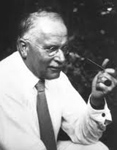 In Modern Man in Search of a Soul, C.G. Jung examines painting as a tool of active imagination in allowing a patient’s unconscious mind to express itself freely:
In Modern Man in Search of a Soul, C.G. Jung examines painting as a tool of active imagination in allowing a patient’s unconscious mind to express itself freely:
It not infrequently happens in these circumstances that the patient has an especially colourful or curious dream, and says to me: “Do you know, if only I were a painter I would make a picture of it.” Or the dreams treat of photographs, of paintings, drawings or illuminated manuscripts, or perhaps of the films.
I have turned these hints to practical account, and I now urge my patients at such times actually to paint what they have seen in dream or fantasy. As a rule, I am met with the objection: “I am not a painter.” To this I usually reply that neither are modern painters—for which very reason modern painting is absolutely free—and that it is anyhow not a question of the beautiful, but merely of the trouble one takes with the picture.
But why do I encourage patients to express themselves at a certain stage of development by means of brush, pencil or pen? My purpose is the same here as in my handling of dreams: I wish to produce an effect. In the childish condition described above, the patient remains in a passive state; but now he begins to play an active part. At first he puts on paper what has come to him in fantasy, and thereby gives it the status of a deliberate act. He not only talks about it, but he is actually doing something about it.
Psychologically speaking, it is one thing for a person to have an interesting conversation with his doctor twice a week—the results of which hang somewhere or other in mid-air—and quite another thing to struggle for hours at a time with refractory brush and colours, and to produce in the end something which, at its face value, is perfectly senseless. Were his fantasy really senseless to him, the effort to paint it would be so irksome that he could scarcely be brought to perform this exercise a second time. But since his fantasy does not seem to him entirely senseless, his busying himself with it increases its effect upon him. Moreover, the effort to give visible form to the image enforces a study of it in all its parts, so that in this way its effects can be completely experienced.
The discipline of drawing endows the fantasy with an element of reality, thus lending it greater weight and greater driving power. And actually these crude pictures do produce effects which, I must admit, are rather difficult to describe. When a patient has seen once or twice how he is freed from a wretched state of mind by working at a symbolical picture, he will thenceforward turn to this means of release whenever things go badly with him. In this way something invaluable is won, namely a growth of independence, a step towards psychological maturity.
The patient can make himself creatively independent by this method—if I may call it such. He is no longer dependent on his dreams or on his doctor’s knowledge, but can give form to his own inner experience by painting it. For what he paints are active fantasies—it is that which activates him. And that which is active within is himself, but not in the sense of his previous error when he mistook his personal ego for the self; it is himself in a new sense, for his ego now appears as an object actuated by the life-forces within. He strives to represent as fully as possible in his picture-series that which works within him, only to discover in the end that it is the eternally unknown and alien—the hidden foundations of psychic life.
Excerpt from the Carl Jung ebook, Modern Man in Search of a Soul